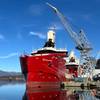USS Buttercup is Still Sinking
By Mass Communication Specialist 2nd Class Brandon Shelander, Fleet Public Affairs Center Atlantic "Battle stations! All hands man your battle stations!" was the cry over the loud speaker. "Two missiles have impacted on the port side!" Sailors wearing coveralls, utilities and khakis rushed to plug the holes and place wooden support beams through out the badly damaged interior of USS Buttercup, a mock ship training facility, as water rushed in through numerous holes and damaged sections of the ship.
Once a month, Mid-Atlantic Region Sailors and Coast Guardsmen test their damage control skills aboard Buttercup, a training simulator that recreates a sinking ship, as part of general shipboard damage control training at Naval Station Norfolk's Center for Naval Engineering. The two-part course is offered to local service members as a way to get familiar with the basics of shipboard damage control and get some hands-on experience. "When an emergency happens on your ship, the odds are you will have never seen it before. Learn damage control, live it and pass it on to your fellow Sailors," said Damage Controlman 1st Class (SW) Raymond Waggy to his 41 students during the classroom phase of the training.
The first half of the training day starts in the classroom where students learn the basics of shipboard damage control. The course covers investigation, pipe patching, plugging, shoring (a method of using wood and metal supports to reinforce parts of a ship) and de-watering. Throughout the classroom instruction, the students are encouraged to ask questions and learn to interact with various damage control props in the room. "We put out our information in a manner that students can relate to," said Damage Controlman 1st Class (SW) John Harrison, an instructor at the school currently on his second tour at the command. "We want them to stay motivated and interested in damage control." Once the classroom instruction is over, the students get a chance to practice what they learned. Buttercup's training facility doesn't look like a ship from the outside, but once inside there's a large rectangular gray-steel box with hatches on top that lead into the replica of a ship's interior. A large control panel on the top deck of Buttercup, which is actually the roof of the steel box, manages the water pumps and controls that simulate a flooding ship and can also tilt the entire structure for realism. The students are divided into three teams upon arrival, with one of the students chosen as the team leader. The teams practice shoring, de-watering, pipe patching and hole plugging before the final event, a hands on test using those techniques inside Buttercup's flooded interior, which puts all the skills and techniques they've learned to the test. "It's going to be challenging to actually do the shoring and patching," said Aviation Support Equipment Technician 3rd Class Sabino Lira, a Sailor from USS Carl Vinson (CVN 70) upon arrival at the facility. Lira's been in the Navy for four years and explained the part of the class that benefited him the most. "Actually having hands-on experience with this kind of damage control will give me a better understanding of the whole process, and most likely I'll be able to explain it to my peers easier since I've actually done it," Lira said. After getting a chance to practice outside the steel box, the students are lined up near the entrance hatches on top of the structure, the lights go out and the attack on the ship begins. Instructors keep a careful eye on the student's progress and guide them through the procedures of rescuing the ship. Under the pressure of rising water and a dark and realistic damage control scenario, all of the topics covered during the classroom sessions and practice are put to the test. How to properly exit a ship is the final lesson taught during the Buttercup training scenario. The instructors make it darker, smoky and turn on spraying water to further limit visibility inside Buttercup. "This is where the best training takes place," said Damage Controlman 2nd Class (SW) Daniel Williams, a field safety instructor for the course. "Because when it's dark and smoky in there, you have to rely on the person in front of you and behind you to make it out." After the event, a very wet Lira had a huge smile on his face. "I'll definitely have more confidence with damage control than I did before," Lira said. "The actual life-like effects are a great teaching tool, plus, the instructors really know what they're talking about, so it's easy to stay motivated."















